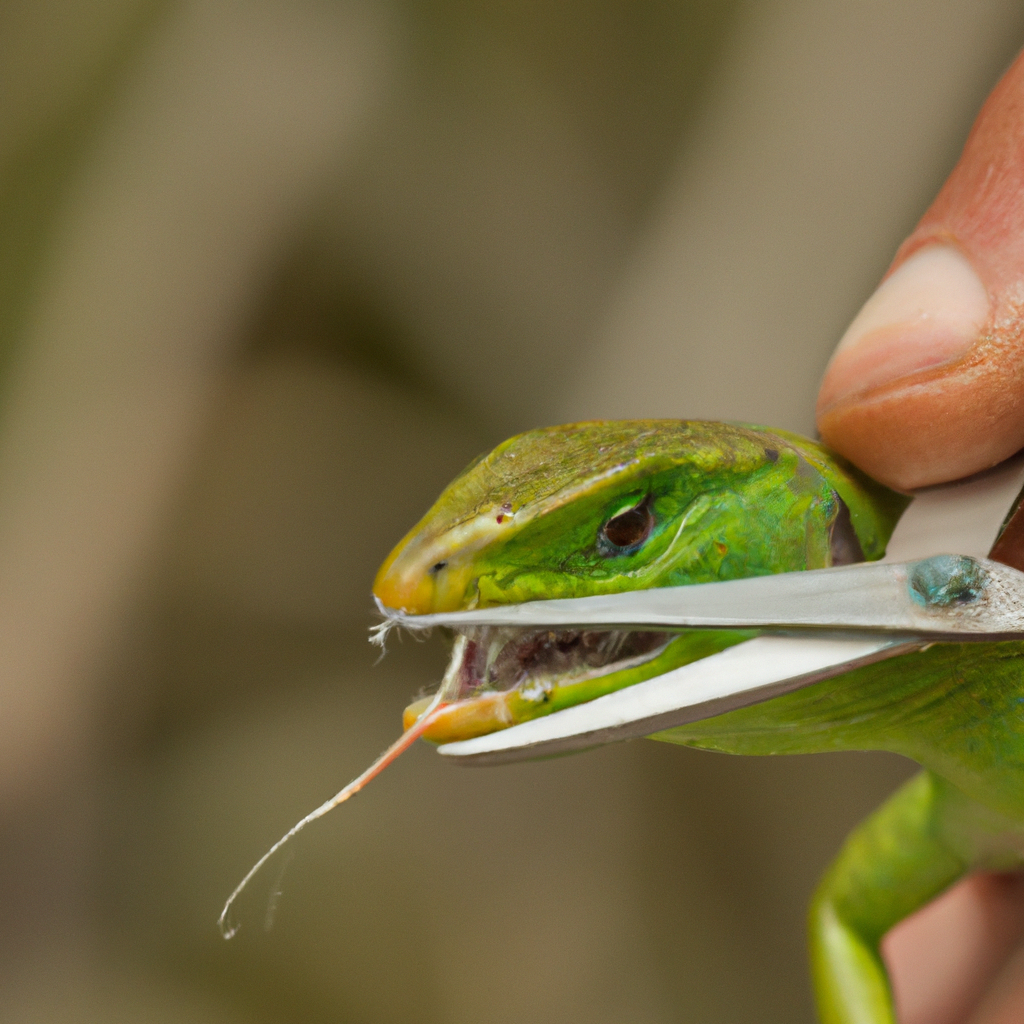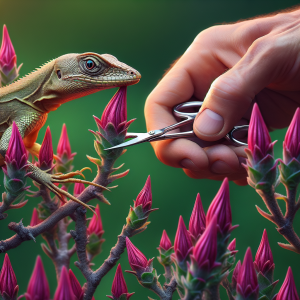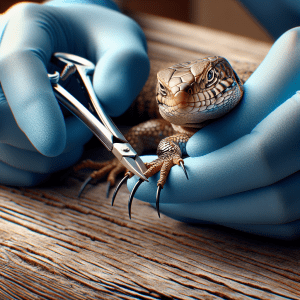Importance of Nail Trimming for Pet Lizards
Have you ever noticed how our pet lizard, Rex, struggles to walk comfortably lately? Well, it turns out that his nails have grown quite long, causing him some discomfort. That’s when I realized the importance of nail trimming for pet lizards like Rex. Just like us humans need regular grooming to stay healthy and happy, our scaly friends also require proper care, including nail maintenance.
I remember the first time I attempted to trim Rex’s nails. It was quite a daunting task, considering how small and delicate his nails are. But with some guidance and the right tools, I quickly learned the ropes. Regular nail trimming not only keeps Rex’s nails at a manageable length but also prevents them from curling or causing potential injuries.
Did you know that neglecting nail trimming for lizards can lead to various health issues? Overgrown nails can interfere with their mobility, making it challenging for them to move around comfortably. Additionally, if left unattended, sharp nails can cause harm to both your lizard and yourself during handling.
By incorporating a routine nail trimming schedule into Rex’s care regimen, I’ve noticed a significant improvement in his overall well-being. He now moves around with ease and seems much happier and more active. It’s amazing how such a simple grooming practice can make a world of difference for our beloved pet reptiles.
So, if you have a pet lizard at home, remember to pay attention to their nail health. Regular trimming not only benefits your lizard’s physical comfort but also strengthens the bond between you and your scaly companion. After all, a happy lizard with well-maintained nails is a healthy lizard!
Benefits of Regular Nail Maintenance for Lizards
Let me tell you about the benefits of regular nail maintenance for pet lizards. It’s not just about aesthetics; keeping your lizard’s nails trimmed is essential for their overall health and well-being. Just like how we humans need regular haircuts or nail trims, lizards also require proper nail care to stay healthy and happy.
Did you know that overgrown nails can lead to various issues for lizards? Imagine trying to walk or climb with excessively long nails – it can be quite uncomfortable and even painful for them. By maintaining the right nail length, you can prevent your lizard from experiencing difficulties in movement and potential injuries.
Proper nail maintenance also benefits you as a lizard owner. Trimmed nails reduce the risk of accidental scratches or injuries when handling your pet. It can make the bonding experience more enjoyable for both of you. Plus, regular nail trims can help prevent your lizard’s nails from getting caught in fabrics or surfaces, reducing the chances of accidents around your home.
Taking care of your lizard’s nails is not as daunting as it may seem. With the right tools and techniques, you can easily incorporate nail trimming into your lizard’s grooming routine. It’s a simple yet effective way to ensure your pet’s comfort and health.
So, the next time you notice your lizard’s nails getting a bit long, don’t hesitate to give them a trim. Your lizard will thank you for it, and you’ll both benefit from a happier and healthier bond. Remember, a little nail maintenance goes a long way in keeping your scaly friend content and thriving.
Tools Needed for Safe Lizard Nail Trimming
Did you know that having the right tools for lizard nail trimming can make the process easier and safer for both you and your scaly friend? It’s like having the right equipment before embarking on an exciting adventure – you wouldn’t want to climb a mountain without the proper gear, right?
When it comes to trimming your lizard’s nails, having the right tools at your disposal is key. Imagine trying to trim those tiny, delicate nails with just your bare hands – not the most efficient or safe method, I must say! That’s where specialized tools come into play, making the task much more manageable and less stressful for both you and your lizard.
From nail clippers designed specifically for reptiles to nail files and styptic powder for emergencies, having a well-equipped lizard nail trimming kit can make all the difference. It’s like having a toolbox filled with gadgets for a DIY project – except in this case, your project is maintaining your lizard’s nail health.
So, the next time you gear up for a lizard nail trimming session, remember the importance of having the right tools by your side. Not only will it make the process smoother and more efficient, but it will also ensure that your lizard stays comfortable and safe throughout the grooming session. After all, a well-trimmed lizard is a happy lizard, ready to conquer the world – or at least its terrarium – with confidence and style!
Step-by-Step Guide to Trimming Your Lizard’s Nails
Let me walk you through the step-by-step guide to trimming your lizard’s nails. It might sound daunting at first, but with the right approach, you’ll become a pro in no time.
First off, you’ll need to gather all the necessary tools for the task. Make sure you have a pair of sharp nail clippers specifically designed for reptiles. It’s crucial to use the right tools to ensure a smooth and safe trimming process.
When it comes to actually trimming the nails, start by gently restraining your lizard to prevent any sudden movements. Remember, patience is key here. Approach each nail carefully, making small, precise cuts to avoid cutting the quick, which can cause bleeding and discomfort to your pet.
If you’re feeling a bit nervous, don’t worry – it’s completely normal to be cautious when handling sharp objects near your lizard. To ease your nerves, you can practice on a fake nail or seek guidance from a reptile vet or experienced lizard owner.
To ensure your lizard’s comfort during the process, you can offer treats or distractions to keep them calm. Positive reinforcement goes a long way in making nail trimming a stress-free experience for both you and your pet.
Once you’ve finished trimming all the nails, take a moment to inspect each one to ensure they are even and smooth. If you notice any rough edges, you can gently file them down using a nail file designed for reptiles.
Remember, regular nail maintenance is essential for your lizard’s health and well-being. Overgrown nails can lead to discomfort and even health issues if left unattended. By mastering the art of lizard nail trimming, you’re not only keeping your pet looking sharp but also promoting their overall health and happiness.
So, are you ready to give lizard nail trimming a try? With a little practice and patience, you’ll soon become a pro at keeping your lizard’s nails in tip-top shape!
Common Mistakes to Avoid During Lizard Nail Trimming
You know, when it comes to trimming your lizard’s nails, there’s always a bit of a debate among lizard owners. Some swear by one method, while others adamantly argue for a different approach. It can be a real challenge to navigate through all the conflicting advice out there.
One of the main controversies surrounding lizard nail trimming is the use of specific tools. Some experts advocate for using specialized reptile nail clippers, while others caution against them, fearing accidental injury to the lizard. It’s a dilemma many lizard owners face when trying to decide the best way to trim their pet’s nails without causing harm.
Another contentious issue is the frequency of nail trimming. How often should you do it? Some say every few weeks, while others suggest waiting until the nails visibly grow longer. It can be confusing to determine the right schedule for your particular lizard, especially with so many conflicting opinions floating around.
Navigating these challenges requires careful consideration and a good dose of common sense. It’s essential to research thoroughly, consult with experienced reptile owners or veterinarians, and ultimately make an informed decision based on what’s best for your individual lizard.
So, next time you find yourself in the midst of the great lizard nail trimming debate, remember to take a step back, weigh the pros and cons, and trust your instincts. After all, no one knows your lizard better than you do.
Tips for Calming Your Lizard Before Nail Trimming
You know, calming your lizard before nail trimming can sometimes be quite a challenge. I mean, imagine trying to convince a tiny reptile that everything’s going to be okay while you’re about to trim its nails! It’s like trying to reason with a stubborn toddler who just won’t sit still.
But here’s the thing – lizards are sensitive creatures, and they can easily get stressed out if they feel threatened or scared. So, the key here is to create a calm and relaxed environment for your lizard before you even think about picking up those nail clippers.
One common controversy that arises when it comes to calming lizards before nail trimming is whether or not to use certain calming techniques or products. Some people swear by playing soothing music or using gentle massage techniques to relax their lizards, while others believe that these methods are unnecessary or even potentially harmful.
It’s essential to understand your lizard’s individual temperament and preferences when it comes to calming them down. What works for one lizard may not work for another, so it’s all about trial and error. And remember, patience is key! Just like us, lizards need time to adjust to new situations and routines.
So, the next time you find yourself faced with the challenge of calming your lizard before nail trimming, take a deep breath, stay calm yourself, and approach the situation with understanding and empathy. Your lizard will thank you for it, and you’ll both come out of the experience feeling a little more connected and a lot less stressed.
How Often Should You Trim Your Lizard’s Nails?
Did you know that the frequency of nail trimming for lizards can vary depending on the species? It’s fascinating how different types of lizards may require different nail maintenance schedules. For instance, some lizards with faster nail growth may need more frequent trimming compared to others. This interesting fact highlights the importance of understanding your specific lizard’s needs when it comes to nail care. By observing your lizard’s behavior and monitoring the length of their nails regularly, you can determine the ideal nail trimming frequency to keep them healthy and comfortable.
Understanding how often you should trim your lizard’s nails is crucial for their well-being. Overgrown nails can lead to various issues, such as difficulty walking or climbing, getting stuck in substrates, and potentially causing injuries. By proactively trimming your lizard’s nails at the right intervals, you can prevent these problems and ensure that your pet remains happy and active.
Factors like the lizard’s age, activity level, and the type of habitat they live in can all influence how quickly their nails grow. Younger lizards tend to have faster nail growth rates compared to older ones, so they may need more frequent nail trims. Similarly, lizards that spend more time climbing or digging may naturally wear down their nails, requiring less frequent trimming.
As a responsible lizard owner, it’s essential to pay attention to your pet’s nail length and be proactive in maintaining them at an appropriate length. By establishing a regular nail trimming routine based on your lizard’s individual needs, you can ensure their comfort and prevent any potential complications associated with overgrown nails. Remember, a little TLC goes a long way in keeping your scaly friend healthy and happy!
Now that you’re armed with this interesting tidbit about nail trimming frequency for lizards, you can tailor your care routine to meet your pet’s specific requirements. Stay tuned for more valuable tips on lizard care and maintenance to keep your reptilian companion thriving!
Alternatives to Traditional Nail Trimming Methods for Lizards
You know, when it comes to trimming a lizard’s nails, there’s actually an interesting fact that many people overlook. Did you know that some lizard species have specialized adaptations that help them naturally wear down their nails? It’s pretty fascinating to think about how evolution has equipped these creatures with unique ways to maintain their nail length.
In the wild, lizards often use rough surfaces like rocks or tree bark to naturally file down their nails as they move around and climb. This natural wear and tear helps them keep their nails at an optimal length for gripping surfaces and hunting prey. However, in a captive environment, where these natural abrasives may be lacking, it becomes essential for pet owners to step in and assist with nail trimming.
By understanding this aspect of lizard behavior, we can appreciate the importance of providing suitable surfaces and materials in their habitat to help them maintain healthy nail length. It’s not just about aesthetics; it’s about ensuring that our scaly friends can move comfortably and function effectively in their environment.
So, the next time you’re trimming your lizard’s nails, remember that you’re not just doing it for cosmetic reasons. You’re helping them maintain their agility and well-being, just like nature intended. It’s a small but significant way to care for these fascinating creatures and ensure they thrive in our homes.
Signs of Overgrown Nails in Lizards and How to Address Them
Let me share an interesting fact about overgrown nails in lizards and how crucial it is to address them promptly. Did you know that overgrown nails can lead to discomfort and even health issues for your pet lizard? Just like how we feel when our nails get too long, lizards can experience pain and difficulty moving around if their nails are not properly maintained.
I remember one time when my friend neglected to trim her bearded dragon’s nails for a while. She noticed that the lizard seemed more hesitant to climb and was occasionally limping. After a visit to the vet, it was confirmed that the overgrown nails were causing discomfort for her beloved pet. That experience made me realize the importance of regularly checking and trimming a lizard’s nails.
Addressing overgrown nails in lizards is essential to prevent potential injuries and discomfort. If you notice your lizard struggling to walk or climb, it might be a sign that their nails need attention. By keeping their nails at an appropriate length, you can ensure that your lizard stays active, healthy, and happy.
So, next time you’re examining your lizard, take a close look at their nails. If you observe them curling or becoming excessively long, it’s time to trim them carefully. Remember, a little maintenance goes a long way in ensuring your pet lizard’s well-being.
Keeping Your Lizard Happy and Healthy with Proper Nail Care
Let me tell you about signs of overgrown nails in lizards and how to address them. It’s a crucial aspect of lizard care that often gets overlooked. I remember when I first noticed my bearded dragon’s nails were getting too long; I didn’t realize how important it was to keep them trimmed until then.
Did you know that overgrown nails in lizards can lead to health issues like difficulty walking or even causing injury to themselves? It’s not just an aesthetic concern; it can impact their overall well-being. That’s why it’s essential to recognize the signs of overgrown nails and take action when needed.
One practical tip I can offer is to regularly check your lizard’s nails to see if they are too long. Look for nails that curl or touch the ground, as these are signs of overgrowth. If you notice this, it’s time to address the issue promptly.
Have you ever faced the challenge of trimming your lizard’s nails? It can be a tricky task, especially if your pet is not used to the process. One approach is to acclimate your lizard to nail trimming gradually, using positive reinforcement and rewards to make it a more comfortable experience for them.
Think about the broader implications of neglecting your lizard’s nail care. By staying on top of nail trimming, you’re not only ensuring their physical health but also fostering a stronger bond with your pet. It’s a simple yet impactful way to show your lizard love and care.
In conclusion, paying attention to your lizard’s nail length is a small but significant part of responsible reptile ownership. By understanding the signs of overgrown nails and taking proactive steps to address them, you can help keep your lizard healthy and happy.




